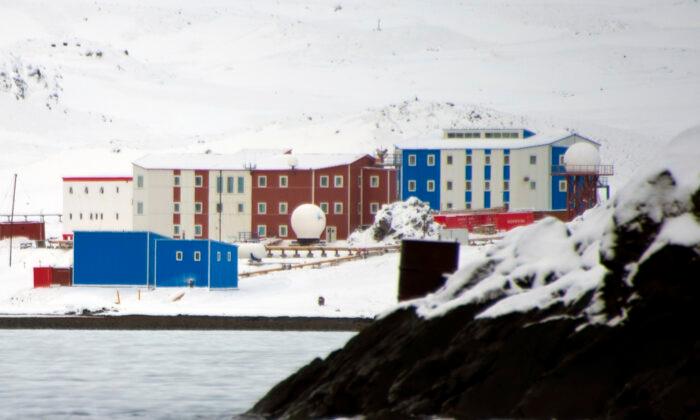President Donald Trump is correct to end America’s adherence to the 1987 Intermediate Nuclear Forces Treaty signed with the former Soviet Union, as this treaty now prevents both the United States and Russia from defending themselves from China’s growing theater-range nuclear missile threat.
Though long viewed as a classic achievement for modern nuclear arms control, the INF treaty was much more a demonstration that peace comes through strength. It was the Soviet Union that began the race in nuclear-armed intermediate-range ballistic missiles (IRBMs) with the 1976 deployment of its multiple warhead SS-20 IRBM.
Washington responded with its precision radar-guided Pershing II IRBMs and its subsonic speed but highly accurate ground-launched cruise missiles (GLCMs). Along the way, President Ronald Reagan had to steel the North Atlantic Treaty Organization (NATO) to resist massive Soviet-inspired protests against the U.S. missiles.
It was Reagan’s strength, and his principled insistence on asymmetric cuts to eliminate these destabilizing weapons, along with his relationship with Soviet leader Mikhail Gorbachev, that made possible the 1987 INF treaty. It banned missiles with a range of 500 to 5,500 kilometers and saw the destruction of 1,846 Soviet and 846 U.S. missiles. The United States, at least, did not redeploy IRBMs—in Europe or in Asia.
By the early 2000s, confidence in the INF treaty was being undermined by a fast-arming power: China.
By this time, China’s People’s Liberation Army (PLA) was engaged in a major buildup of short-range (SRBM, 300 to 600 kilometers) and medium-range ballistic missiles (MRBM, 1,000 to 3,000 kilometers). By about 2010, China’s SRBMs had plateaued at about 1,200 Dongfeng-11s (DF-11s) and DF-15s, aimed at Taiwan.
But aided by U.S. Pershing II technology obtained via espionage, the PLA also was deploying highly accurate radar-guided warheads and new anti-ship warheads on its 1,500km range DF-21 MRBMs. About that time, the PLA also was positioning its very accurate 1,500km range DH-10 GLCM.
More PLA missiles followed, such as its 800-to-1,000-kilometer-range DF-16, which flies at greater speeds to defeat Taiwan’s missile defense interceptors. Then, in 2014, the PLA introduced its 4,000-kilometer-range DF-26 IRBM, announcing that it was armed with nuclear and anti-ship warheads.
In the past year, it was disclosed that the PLA deployed a new 800km range DF-17, reportedly armed with the world’s first hypersonic glide vehicle (HGV) warhead, which is very maneuverable, making it difficult to defeat with current missile defenses. Furthermore, the PLA navy intends to deploy long-range HGV-armed ballistic missiles on its ships, Chinese sources say.
But that’s not all. China has played some role in helping North Korea to obtain both theater-range and nuclear intercontinental ballistic missiles (ICBMs). North Korea’s liquid-fueled Hwasong-14 and Hwasong-15 ICBMs ride on transporter-erector-launchers (TELs) made in China, while future North Korean solid fuel ICBMs and MRBMs also will ride on Chinese-made TELs. That serves to raise the legitimate concern that China is also aiding Pyongyang’s missile developments, to pose an indirect threat to the United States and its Asian allies.
Some number of the PLA’s SRBMs, MRBMs, and IRBMs are armed with nuclear warheads. The Department of Defense annual report on China’s military power doesn’t mention nuclear-armed SRBMs but does note that MRBMs and IRBMs can be nuclear-tipped. However, this report doesn’t provide numbers for theater-range nuclear warheads, which today pose a direct threat to Taiwan, India, Japan, South Korea, and to U.S. forces in Japan, South Korea, and Guam. They also undermine the confidence of U.S. allies in the U.S. extended nuclear deterrent.
Over the last decade, there has been interested from the Russians, U.S. arms controllers, and some conservatives in convincing China to join the INF treaty, in hopes of heading off expanded missile competition. Beijing’s longstanding response to most entreaties that it join arms-control agreements is that its small arsenal gives it “immunity” from such agreements, along with saying that Russia and the United States should first reduce their arsenals. Beijing also refuses to offer any public data on its nuclear weapons numbers or deployments and has regularly rebuffed the U.S. attempts to begin preliminary discussions about nuclear-arms control.
While concern about China’s growing missile force helped to undermine Russian support for the INF treaty, Moscow has been quicker to blame the deployment of U.S. missile defenses in Europe as violations of the INF, thus justifying its new missiles such as the 1,000-kilometer-plus-range SSC-8/R-500 GLCM.
But Russia has also decided to increase its economic dependence on China, with the added “payoff” of increased military and strategic cooperation. So far, they have held two command-post “missile defense” exercises, raising concerns about possible “missile offense” cooperation.
While the United States would have been justified in withdrawing from the INF treaty late in the Obama administration, it took President Trump to remove this impediment to U.S. security interests. The U.S. Army has disclosed plans to develop new, more effective SRBMs and has indicated it would like to develop new MRBMs, as well, which wouldn’t be possible under the INF treaty.
President Obama’s 2010 decision to destroy the last U.S. theater nuclear missiles, submarine-launched Tomahawk cruise missiles in storage, likely encouraged Russia and China to expand their theater missile arsenals, which is why Trump’s decision to withdraw from the INF treaty has long been necessary. The U.S. Army now wants to develop new, more effective SRBMs and has indicated it would like to develop new MRBMs as well, which would not be possible under the INF Treaty.
Such missiles have long been required to deter North Korean nuclear-missile aggression and also to deter China from taking advantage by attacking Taiwan.
By deploying new ground, sea, and air-launched missiles with tactical nuclear warheads, the United States can restore a new balance of power in Asia. The history of the INF treaty indicates that only then will China and Russia become interested in arms control.





